We surveyed the organisers of the Network Operator Groups (NOGs) in our service region to get a comprehensive overview of how these groups are run and the challenges they face in bringing together the technical communities in their countries and cities.
NOGs are an essential part of the Internet community and they carry out a similar function to the RIPE community on a national or local level. They connect people with similar technical interests, either at meetings or online, and they give participants the chance to share ideas and make personal connections in their communities. The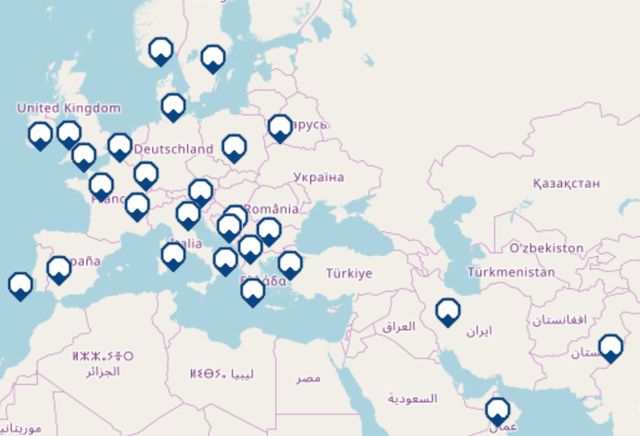
At the end of 2017, we established a mailing list for NOG organisers on our comprehensive NOG pages on RIPE Labs so that they could share useful information and experiences, and also make it easier for them to coordinate meeting dates and other logistical considerations. While establishing this mailing list, we thought this would be the perfect opportunity to survey the organisers to help us get an overview of the current situation with NOGs in our service region.
We asked them to complete a two-part survey – the first part concerns details about how their NOGs are organised and it forms the basis for this article. The second part of the survey asked more specific questions about the experiences the organisers have had with setting up and running their NOGs, and we will use the information gathered there to write articles on those NOGs. The sections below are headed by the questions we asked in part one of our survey. Question 1 asked for the name of the NOG and is not included.
Q2. When was your NOG set up?
The very first NOG to be set up in our service region was SwiNOG in Switzerland way back in 2000. They’ve held 32 meetings since the very first one in Berne and have grown from strength to strength. In 2002, some of the larger countries in Western Europe established their NOGs, with NLNOG in the Netherlands, FRNOG in France and SOF in Sweden becoming established. UKNOF, one of the largest NOGs in terms of attendance, then set up in 2005. In 2010, TRNOG in Turkey became the first operator group from the MENOG region.
The expansion of NOGs beyond Western Europe started with PLNOG in 2008 but it picked up steam from 2013 with the launch of SINOG in Slovenia and many more from the South-East Europe region soon after. 2016 was notable in that we get the first of the city NOGs, NetMcr in Manchester, kicking off its meetings. 2017 was a bumper year for new NOGs with four groups establishing themselves, including IRNOG in Iran. And already for 2018, there are plans to launch LUNOG in Luxembourg this coming November.

Attendees at ALNOG, the latest addition to the NOG family, are excited about getting started
What’s striking about the spread of NOGs in our service region is the similarity to the development of the RIPE community, beginning in Switzerland and the Netherlands and other large countries in Western Europe before extending to the East and South before eventually moving beyond Europe into the Middle East. It will be interesting to see if new NOGs are established in the further reaches of our service region in the coming years, and if city NOGs such as NetMcr will become another feature in the growth of the NOG phenomenon.
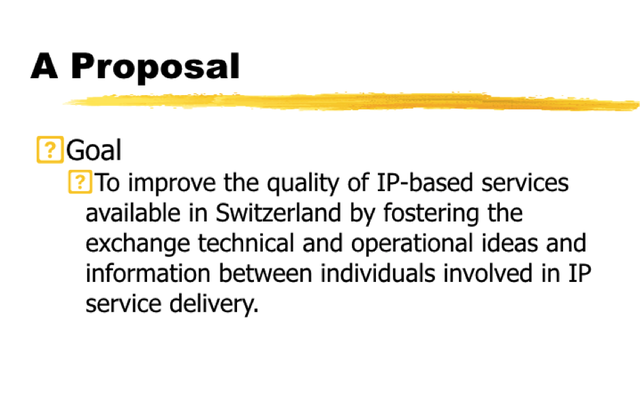
A slide from the first presentation given at the first NOG set up in Europe
Q3. How many people are organising your NOG?
Q4. Do you use volunteers as well as the main organising committee?
The question “How many people are organising your NOG?” was one we thought would be pretty simple and involve mainly numeric responses from two to ten. Not so! Although the majority of NOGs are organised by single groups sized in this number, several do not have a single organising group but are instead directed by a combination of Programme Committee, Board of Directors, events manager or even by separate entities such as the local IXP. It appears that this is especially the case with some of the older and more established NOGs, which is perhaps an indication of the increasing complexity that comes with running a successful NOG with growing attendances.
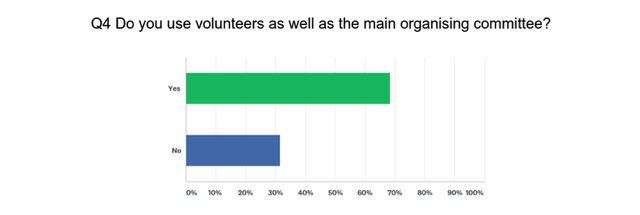
12 respondents used volunteers as well as their main organising committee
Most NOGs, with the very new ones and those not holding events being the main exceptions, rely on volunteers to help them run their meetings and social events. Many of our respondents noted in part 2 of the survey that getting volunteers to assist in running their NOG meetings or take part on Programme Committees was one of the most important and most difficult tasks necessary to run a successful NOG.
So, if you are a regular NOG attendee and you would like to contribute to your community, why not talk to the organisers at the next event and let them know you’re available to help out in some capacity. Chances are good that it will be very much appreciated.
Q5. How many meetings do you have per year?
Q6. How long do your meetings last?
Frequency and length of meetings was another area we surveyed and, again, we had our NOG organisers reaching for the “Other” and “Comment” boxes.
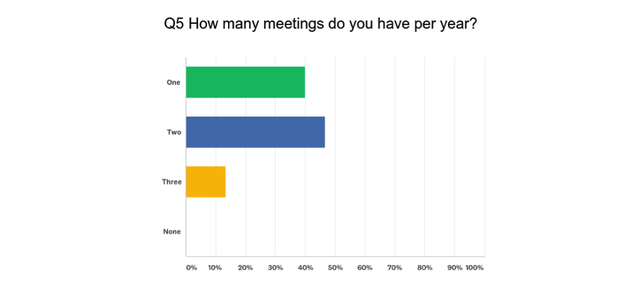
15 of 20 respondents held one, two or three meetings per year
While the majority of the NOGs hold one, two or three events per year, our comments showed that other NOGs such as NetMcr in Manchester hold 12 evening events per year. Across the water, the Irish iNOG holds four to six events per year with each one needing considerable resources in terms in volunteer time and effort to put together. And this is before we consider whether workshops and tutorials organised by the NOGs for the benefit of their communities can be categorised as “events”. GRNOG offers technical workshops as well as its more traditional event. BG.NOG in Bulgaria has no official event and operates on a mailing list, but it is currently discussing the possibility of running a BGP workshop in Plovdiv.
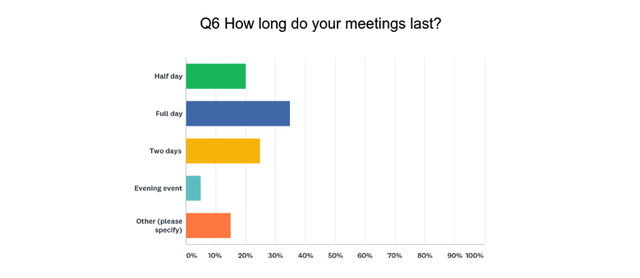
A third of respondent NOGs fall in the one-day meeting category
Just over a third of NOGs surveyed hold one-day events with many having social occasions attached. DKNOG, ESNOG, SINOG, PLNOG and DENOG are the five respondents who have longer programmes with two-day events. But even here, some of the NOGs defy easy categorisation. For instance, NLNOG holds a New Year’s evening event, an afternoon event and one full-day event. It’s worth reading this previous RIPE Labs article from NLNOG organiser Job Snijders for a concise overview of how a NOG develops over time and the hurdles it must overcome (very creatively in some ways) to stay relevant and maintain its attractiveness for the local networking community.

Starting with five guys, iNOG has evolved into a large and more diverse event - they even have their own logo!
Q7. How many attendees do you get on average?
Q8. How do you communicate with your community?
Of the 20 NOGs that responded to our survey, 14 receive attendances from 50-200 people for their events. This is very impressive for national groups, and what is also notable are the outliers on the edge of the scale.
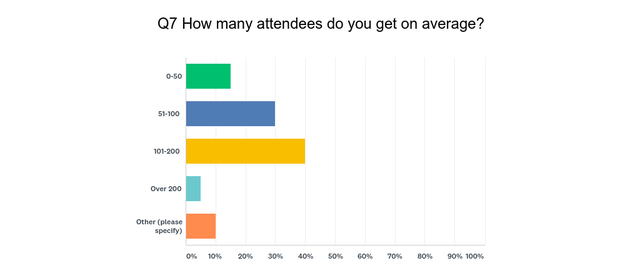
Three NOGs operate on a smaller scale and have fewer than 50 attendees – this applies to NOGs that run more frequent events in smaller locations. At the other end of the scale, UKNOF noted that it receives up to 350 attendees for its one-day events while PLNOG in Poland has approximately 800 attendees for its two-day events. The differences among NOG attendances highlight the fact that NOGs will work in many different ways and will develop according to the needs of the local community, whether that’s small and intimate or targeted at the masses. In both cases, and for the majority in between, the goals and outcomes are largely the same.
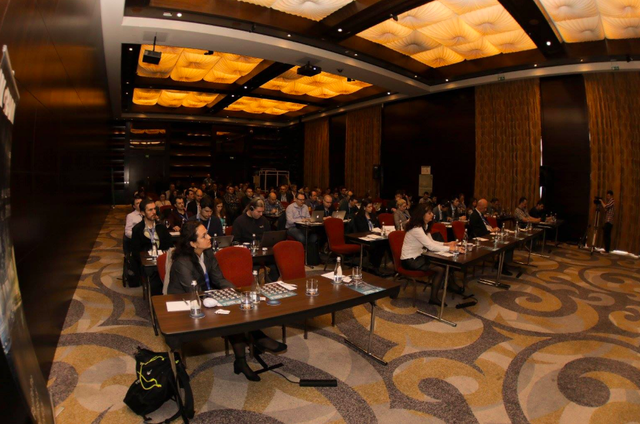
Attendees at RONOG 4 in Bucharest in November 2017
If we look at the approximate attendances for the NOGs surveyed and factor in the frequency of their events, we can have a rough guess at the approximate total of attendance for these NOGs in a given year. Approximately 6,000 people (including those who will attend more than once and who will attend several NOGs per year) registered for NOG events in 2017. When participating at a specific NOG, it’s always heartening for people to see a large portion of their community come together to discuss topics of mutual interest. It’s also worth realising that across the region there is a much larger group of operators who are coming together to do the exact same thing and with the same vision of connecting people in their cities and countries.
So how are the NOGs getting in touch with their communities? – people who regularly go to their events and those all-important potential participants? Hardly surprisingly, mailing lists are used by 19 out of 20. Website updates and social media are also used by the majority, while personal contact is a key feature for many. IRC is perhaps lower than you would expect for the network operator community but still used by one in five NOGs.
Of those who chose “Other”, Slack, Telegram, Youtube and meetup.com were mentioned. And PLNOG also mentions “media” as a way of communicating. Does PLNOG get large attendances partly due to communicating via media generally or are larger attendances an enabling factor in the use of more traditional media, such as inviting TV crews to promote events?
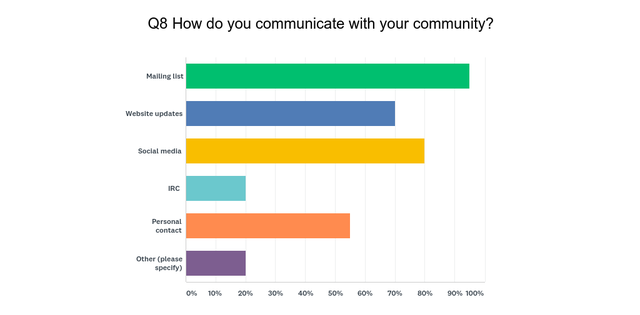
Q9. Is your NOG set up as a legal organisation?
Q10. How do you finance your NOG’s operations and events?
Q11. Approximately how much money does it cost to run your events?
The next three questions get down to some organisational nitty gritty. Are the NOGs set up formally and legally or are they run on an informal basis? And what are the financial considerations that the NOGs have to take into account when running events?
Only five of the 20 NOGs who responded are set up as legal organisations. This includes four of the oldest NOGs in the region (SwiNOG, NLNOG, DENOG and UKNOF) as well as ITNOG in Italy, which might provide food for thought for many of the newer NOGs that been established recently. Job Snijders notes in his NLNOG article that “[w]hen financial and insurance issues are involved, like bank accounts or commercial venue contracts, you need a formal entity.” In some of the countries where there are NOGs it can be the case that another organisation in the technical community, such as the IXP, acts as the formal institution that can deal with contractual and financial matters on behalf of the NOG.
And in terms of getting financial support to run a NOG, sponsorship is clearly the most common source of revenue. So if your business wants exposure among technical communities and wants to support the development of NOGs in those communities, well, you know what to do…
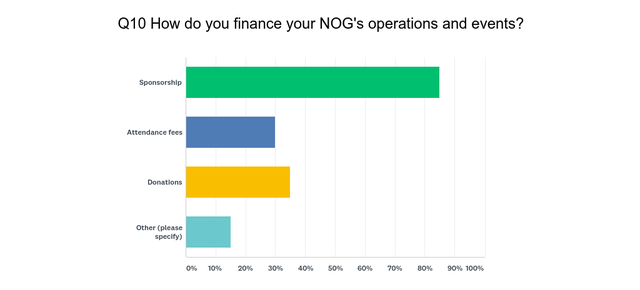
Sponsorship is the financial lifeblood of NOGs in our region
We also asked how much it costs to run a NOG event. The answers clearly depended on the size of the meeting, with 11 NOGs falling in a range from EUR 1,000 to 10,000. Eight of the NOGs run events that cost over EUR 10,000 to run.
Q12. Do you have a social event attached to your NOG?
Q13. How do you solicit feedback from participants at NOGs?
All but three groups have a social event attached to their NOG, and in a couple of cases the social part of the NOG is the main focus with presentations interspersed during the social occasion. For most, the social events take place straight after the presentations end and give attendees the chance to connect with like-minded people in their communities in an informal setting, share ideas and, importantly, have fun. While the content presented at the events is obviously a key factor in attracting participants, giving people space to meet new people and old friends is a key ingredient for a successful NOG. And it goes without saying, it would be hard to do business without a good coffee break!
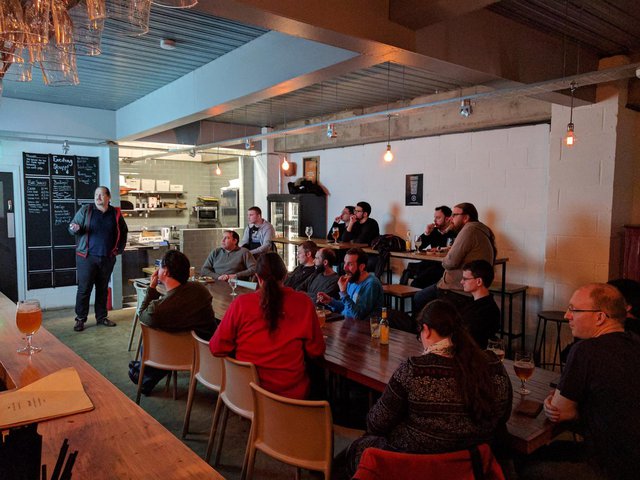
NetMCR, the NOG in Manchester, is set up as a social event with presentations
Getting good feedback from participants is essential for NOG organisers to help them develop with the community’s wishes in mind. This is how groups evolve and improve over time. Nine of the NOGs in our group send feedback surveys to participants while half of the NOGs rely on personal conversations with attendees to get input on how attendees experience the NOG events. As someone who works for an organisation that loves to get feedback, I can only advise that you take the chance to give feedback to NOG organisers whenever they ask for it. It really does help them to figure out the best way to create a worthwhile experience at future events.
Q14. Do you benefit from what the RIPE NCC has to offer NOGs?
The last question in our survey asked NOG organisers if they were taking advantage of what the RIPE NCC can offer in terms of support. We are happy to see that the vast majority of NOGs take support from us, with 75% inviting our staff to speak at their events. We will continue to attend and to provide support to NOGs in 2018, and we are especially looking forward to helping new NOGs to establish themselves and grow their communities.
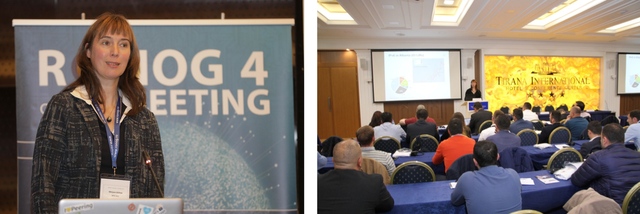
Mirjam Kühne, Senior Community Builder at the RIPE NCC, presenting at RONOG and ALNOG in 2017
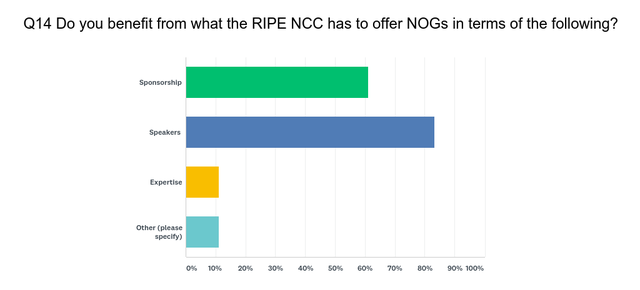
RIPE NCC speakers - a popular choice for the discerning NOG
Conclusion
The Internet is a global phenomenon and operators across the globe face the same issues every day, but it is clear that local coordination is something that is not only necessary but is actively sought out by technical communities. The NOGs that allow this to happen fulfill an extremely important function in the countries in our service region. And while that function is something that is common to all, the way they carry it out is highly dependent on specific local circumstances, culture and preferences.
By looking at the NOGs as a group, we are given a picture of great diversity and adaptation to local needs. We also get a sense of the scale of these efforts across a large area, with thousands of operators actively participating and sharing their own experiences with their peers. We can also start to understand the time and effort that are freely given by the people who organise the events, create the websites and mailing lists, search for interesting content for their audiences, and much more besides.
On that note, we would like to thank the following NOGs who responded to our survey and who therefore contributed to this article. All NOGs depend on their communities for survival, so we at the RIPE NCC highly recommend that you support your local NOG (and even your not-so-local NOGs) through attendance, by answering calls for presentations, and by offering your time and assistance where possible.
| NOG Name | Country | Established |
|---|---|---|
| ALNOG | Albania | 2017 |
| NOG.BG | Bulgaria | 2014 |
| DKNOG | Denmark | 2011 |
| FrNOG | France | 2002 |
| DENOG | Germany | 2001 |
| GRNOG | Greece | 2015 |
| IRNOG | Iran | 2017 |
| iNOG | Ireland | 2011 |
| ITNOG | Italy | 2009 |
| NLNOG | The Netherlands | 2002 |
| NONOG | Norway | 2017 |
| PLNOG | Poland | 2013 |
| PTNOG | Portugal | 2017 |
| RONOG | Romania | 2014 |
| RSNOG | Serbia | 2015 |
| SINOG | Slovenia | 2013 |
| ESNOG | Spain | 2008 |
| SwiNOG | Switzerland | 2000 |
| NetMcr | Manchester, UK | 2016 |
| UKNOF | United Kingdom | 2005 |

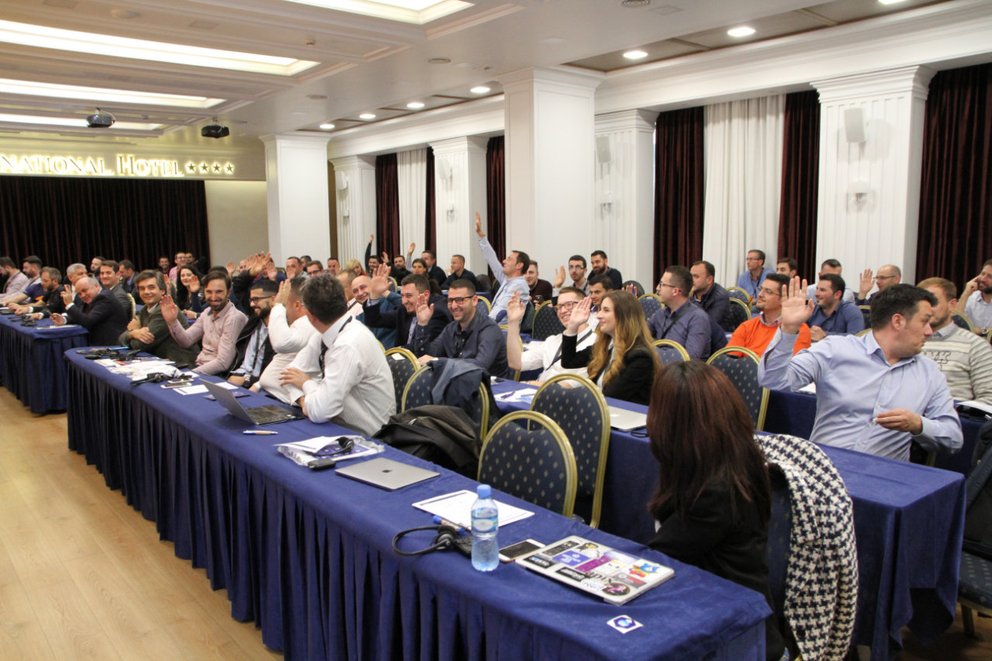


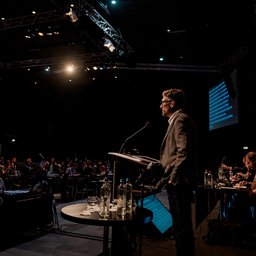
Comments 5
The comments section is closed for articles published more than a year ago. If you'd like to inform us of any issues, please contact us.
Donal O Duibhir •
Hi, Donal from iNOG here, great post! To add: we have a page on how we host, by the numbers, https://inog.net/host which we give to hosts/venues and hope other NOGs can benefit. We also try to set expectations when canvassing speakers https://inog.net/talk One of the most important things we have found (for community) is to capture and share content with videos on the main page https://inog.net hosted from https://youtube.com/inognet And just to note that iNOG is a rebooted non-traditional NOG ~2015 which used to exist in the form of a mailing list that died in 2005 or so. If anyone from that original list (or has archives) please get in touch mailto:admin@inog.net as we're having trouble locating original members.
Roman Hochuli •
Hi Donal Roman from SwiNOG here. We are contemplating the video-capturing of the events for delayed release as a service to the community. So far, offers for running the video operation never materialized, but we may try to run it ourselfs at one of the next events and would be interested to hear what worked for you and how. Can you elaborate a bit on how you are (technically) doing the videos? Are you streaming live or only on-demand and why? Feel free to get in touch directly Roman roman@swinog.org
Donal O Duibhir •
Hi Roman, Great question. Currently we capture and share after the event on youtube https://youtube.com/inognet and have started splitting the video talks up individually -> which gives us a drip feed of content with their own metrics, links, OG tags etc. We have not yet managed to do streaming but are working on it for the next one! As we move spaces each iNOG, it's highly dependent upon what's available to us from in-house to borrowed equipment but there's usually 4 options and then we also post/share on https://inog.net a) We normally borrow a camera and wireless microphone from a department of HEAnet in Ireland i.e. HEAnet multimedia division https://www.heanet.ie/services/multimedia (Thank you!). Am guessing there should be an equivalent sub-department in https://www.switch.ch/edu/ ? We then end up spending about 4-6 hours editing the video. We have found that cropping the video to the presenters head or top half is best and then placing that over a full screen slide is best for file size/storytelling (using the PiP(Picture in Picture) option). I use iMovie on Mac OSX. Sound quality and bad lighting for live demos are always our biggest challenges. b) The other option we sometimes have is to use the host venue's in-house video conferencing system (Cisco Webex/Zoom etc) to record the video/sound but *always* try and get the HEAnet camera as a backup running concurrently. It's super important to run tests in advance with speakers, laptops, and local IT/AV to gain confidence for the event. c) The host venue paid for their own videographer to come in and record the sessions which was *ace* as it meant we could just wait a few days for a finished product and focus 100% on spacemaking, organizing, hosting, and user experience. d) The most amazing set up so far has been with Facebook who have a professional level recording studio set up in their event space with awesome lighting and multiple cameras + microphones + production desk: https://goo.gl/EnuQFz = wonderful! But we had to wait for legal teams to clear their talk video before releasing, so watch out! Note: We feel very lucky when the host venue/ sponsor org looks after us as per (c) and (d). (b) is great too in terms of time and effort, and (a) we are always super grateful for - but it means the most work on our end. It's important to have someone volunteer to be 100% responsible for the A/V(Audio Visual) at the event and also tasked with delivering/chasing the final product. Beggars can't be choosers, but definitely try and factor AV in to your location decision making, including in to checklists and 'runsheets' for the night. We would love to build out our own "pod" for event recording as any external providers normally charge a lot (and we do everything with no budget i.e. for free). We're tracking some possible solutions for our own pod here https://goo.gl/tCctX2 for some future scenarios/funding. Once you have a small library of content, we then have bots that post videos via Twitter and in our Slack channel to help learning and growth for all. We also feel it's important for growing community that potential new members and speakers can visualize and associate with posted content... as a sort of "show me" rather than "tell me" due to the fact that humans like to see other humans which helps them envision themselves there already. Hope this helps, Donal @inognet
Daniel Rösen •
DENOG was founded way earlier than 2009. I have created the DENOG mailing list in July 2001, and the IRCnet channel #DENOG even preceded that, I think it was 1999 or 2000. Only the meeting gatherings have started much later in 2009. For the sake of this article, assume 2001 as founding year I'd say. :-) Best regards, Daniel (co-founder DENOG)
Mirjam Kühne •
Hi Daniel, thanks for clarifying. I changed the date in the table.